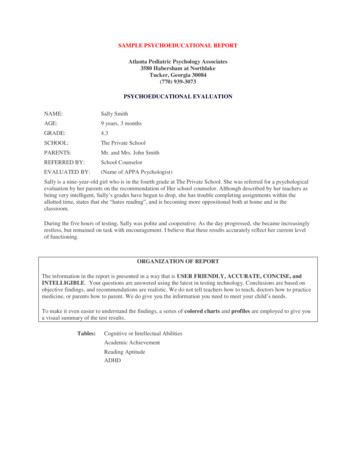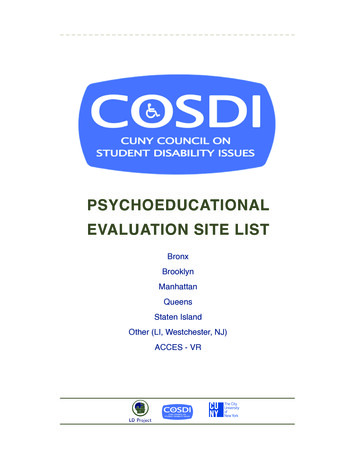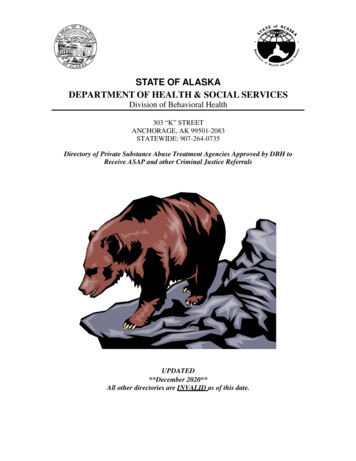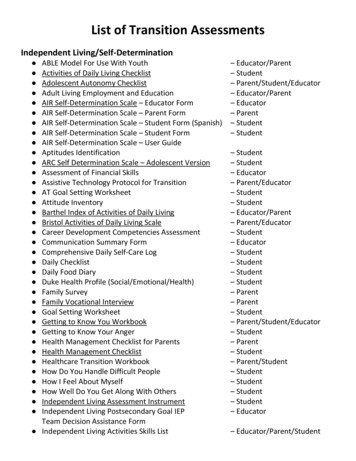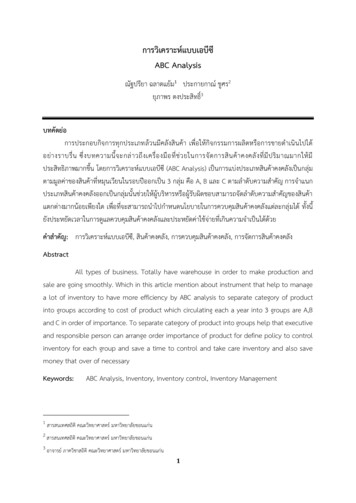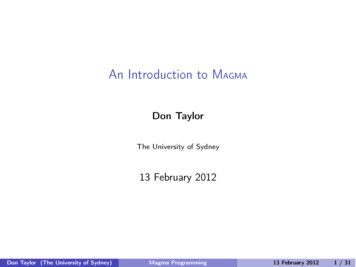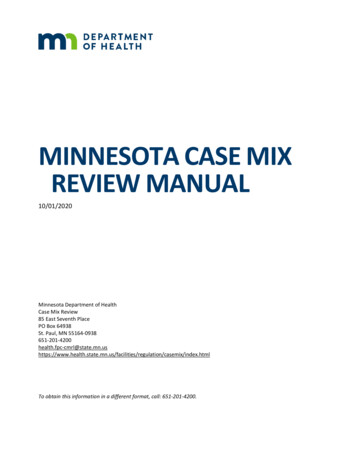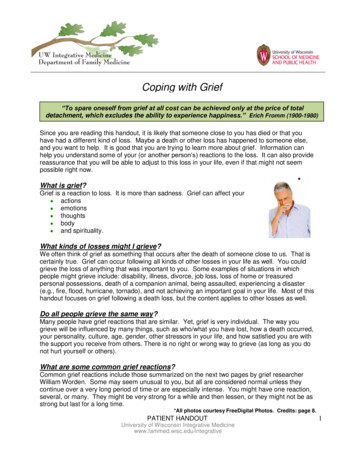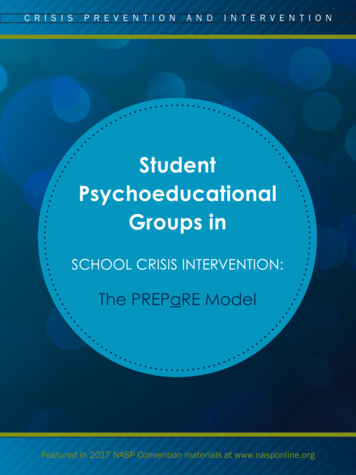
Transcription
C R I S I SP R E V E N T I O NA N DI N T E R V E N T I O NStudentPsychoeducationalGroups inSCHOOL CRISIS INTERVENTION:The PREPaRE ModelFeatured in 2017 NASP Convention materials at www.nasponline.org
CopyrightThe views, opinions, and content of this publication are those of the authorsand do not necessarily reflect the views, opinions, or policies of the NationalAssociation of School Psychologists (NASP) and are not a part of the officialNASP PREPaRE book or associated trainings. This publication is intended toprovide complementary tools within the PREPaRE framework that are readyfor use in schools during the post-impact and recoil phase of a crisis.Published by Sheila E. Stein and Stephen E. Brock 2017, Sheila E. Stein and Stephen E. Brock.All rights reserved. Individuals may download and use this manual andthe materials within for educational and direct service provision purposeswithout specific permission of the authors or NASP. When using excerptedcontent, citation of the sources is appreciated.
STUDENT PSYCHOEDUCATIONAL GROUPS IN SCHOOL CRISIS INTERVENTION: THE PREPaRE MODELAcknowledgmentsThis document was written by Sheila Stein, Ed.S. for the 2017 National Association of SchoolPsychologists (NASP) Annual Convention in San Antonio, Texas. Dr. Stephen Brock, Ph.D.was a contributing author, and is the first author of NASP‘s PREPaRE Workshop 2 entitled CrisisIntervention and Recovery: The Roles of School-Based Mental Health Professionals. Additionalcontributors to the original curricula include Kelly Chiolan, Ed.S. and Amanda Campisi, Ed.S.ELECTRONIC ACCESS AND COPIES OF PUBLICATIONThis publication may be accessed electronically through the following connections: www.nasponline.org and navigating to the 2017 NASP Annual Conference page; and Dr. StephenBrock’s homepage at http://www.csus.edu/indiv/b/brocks/RECOMMENDED CITATIONStein, S.E., & Brock, S.E. (2017). Student psychoeducational groups in school crisis intervention:The PREPaRE model. Retrieved from http://www.csus.edu/indiv/b/brocks/Additional Reviewer and Graphic Design Support: Stacy MaaloufImages of children’s emotions are licensed by www.DancingCrayon.comTo access this curricula quickly from Dr. Brock's page,please scan the QR code to the right and click the linkunder Workshop Presentations.3Stein & Brock, 2017
““Within the context of school mental healthcrisis intervention,Psychological Educationis the provision of direct instruction and/orthe dissemination of information thathelps crisis survivors and their caregiversin understanding, preparing for, andresponding to the crisis event, and theproblems and reactions it generates (both„in themselves and among others).Brock (2011)
STUDENT PSYCHOEDUCATIONAL GROUPS IN SCHOOL CRISIS INTERVENTION: THE PREPaRE MODELForewardIN 2016, THE SECOND EDITION OF SCHOOL CRISIS PREVENTIONAND INTERVENTION: THE PREPaRE MODEL WAS PUBLISHED.The lesson plans and curricular materials located within this publication have been developed tofit within the updated PREPaRE model and are available free of charge. They are recommendedfor use as a Tier 2 intervention with selected individuals and groups after a crisis has occurred.Stein, Chiolan, Campisi, and Brock developed the first edition, which was produced for amini-skills presentation at the NASP annual conference in February of 2015. The lesson plans inthis handbook continue to be recommended for use among school psychologists, teachers,counselors, administrators, and other trained school staff.In an effort to increase readability, enhance online access, andimprove user experience, this second edition includes importantrevisions to the original set of documents. In subsequent pages,the reader may observe the ways in which materials can bedifferentiated for an audience of second language learners,diverse cognitive abilities, and various chronological ages. Thesessions are concerned primarily with helping students learn totake care of themselves, and secondarily with teaching themhow best to take care of their peers. Enrichment activities havebeen added, and may be used in some cases as a substitutefor other activities in classrooms. An objective of this revision isto expand the documents to a wider audience.“Students receivingthis interventionmay be in classes,in preexisting groups(e.g., the debateteam), or withother individualsselected based onpsychological triage„data.Brock, 2016The main purpose of this guide is to assist schools in preparing forcrisis intervention. Materials may be used to train staff in developing a general understanding ofa crisis, possible outcomes to crisis exposure, and staff’s role in the delivery of psychoeducationto students. Many special populations are not specifically identified or addressed. The authorssuggest further training in cultural competency, disabilities, and second language acquisitionto enhance the effectiveness of the intervention among various populations. Although theauthors hope readers will find this guide useful, they also recognize it is by no means intendedto provide comprehensive information on crisis prevention and intervention or meet the needsof all special populations.This publication is a step toward developing staff capacity in facilitating effective psychoeducation in the school setting to selected students after a crisis.Sheila E. Stein, Ed.S., NCSP and Dr. Stephen E. Brock, Ph.D., NCSP, LEP5Stein & Brock, 2017
STUDENT PSYCHOEDUCATIONAL GROUPS IN SCHOOL CRISIS INTERVENTION: THE PREPaRE MODELContentsORGANIZATION OF THIS GUIDE 7BACKGROUND ON SPGs 9LESSON PLANS 13Primary Grades 14Upper Elementary 24Middle School 34High School 44Enrichment Lessons 54PARENT INFORMATION 59REFERENCES 616Stein & Brock, 2017
STUDENT PSYCHOEDUCATIONAL GROUPS IN SCHOOL CRISIS INTERVENTION: THE PREPaRE MODELOrganization of this GuideCHAPTER ONE Provides a background on student psychoeducational groups and may beuseful when training staff on lesson plans and curricular materials before a crisis has occurred.It includes a review of the goals and steps of a student psychoeducational group lesson.CHAPTER TWO Lesson plans are sequenced by the following grade levels:PG. Primary Grades (K-3)UE. Upper Elementary (4-6)MS. Middle School (7-8)HS. High School (9-12)Practitioners will want to select materials matching students’ linguistic competence, cognitiveabilities, and developmental levels. The aforementioned grade levels are general guidelines. Alllesson plans have been designed with the same lesson goals and procedural steps. The figurebelow illustrates a continuum of differentiation underlying the four levels and correspondingmaterials.7Stein & Brock, 2017
STUDENT PSYCHOEDUCATIONAL GROUPS IN SCHOOL CRISIS INTERVENTION: THE PREPaRE MODELHandouts for the lesson plans can also be found in Chapter Two. These include templates toguide staff's dissemination of crisis event information to students, help students identify commoncrisis responses and reactions, and support them in developing plans for self-care. Othertemplates include a check for understanding and a stress management resource. Please noteeach step does not require a handout. Enrichment activities are included at the chapter's end.CHAPTER THREE A sample letter for parents or caregivers to provide them with more informationabout the psychoeducational group after the lesson has been delivered. There is a specialremark about social media and locating additional supports. It is important for schools tofamiliarize themselves with the content of the letter and adapt it to fit the circumstances of thecrisis, school culture, and resources available.REFERENCES References are provided for practitioners' further review.8Stein & Brock, 2017
STUDENT PSYCHOEDUCATIONAL GROUPS IN SCHOOL CRISIS INTERVENTION: THE PREPaRE MODEL1BackgroundON STUDENTPSYCHOEDUCATIONAL GROUPSA Tier 2 Intervention
STUDENT PSYCHOEDUCATIONAL GROUPSAND THE PREPaRE MODELThe mental health needs arising from any crisis situation are unique and require multiple levelsof response. The PREPaRE model is a framework of crisis prevention and intervention designedfor schools to address students’ mental health needs.Prevent and prepare for psychological traumaReaffirm physical health and perceptions of security and safetyEvaluate psychological trauma riskProvide interventionsandRespond to psychological needsExamine the effectiveness of crisis prevention and interventionsA crisis can be characterized as an event perceived to be very negative, generates feelingsof powerlessness or entrapment, and may occur suddenly or unexpectedly. Examples ofcrisis events include natural disasters, human-caused disasters, acts of war/terrorism, violent orunexpected death, threatened death and/or injury, and severe illness or injury.An unexpected event in which individuals feel defenseless can also disrupt their emotionalbalance. Possible consequences of crisis exposure include emotional, cognitive, behavioral,and physical reactions. Executive functions—including paying attention, rememberinginformation, initiating and completing tasks, problem solving, and inhibiting impulses—maybe disordered. Students may experience academic decline, increased behavioral problems,or truancy. Maladaptive coping strategies (e.g., alcohol or drug use) can result in long-termdifficulties like mental illness or psychopathology. For some students, interventions like a studentpsychoeducational group can accelerate their psychological recovery. While many may notneed this level of support, still others need much more involved and long-term psychotherapeuticinterventions.While an acute crisis has the potential for negative outcomes, it also may result in extremelypositive outcomes. Adaptive coping strategies can increase students’ resiliency and facilitatea return to emotional equilibrium. The expectation is that most students will return to a stableemotional state after a crisis.The Student Psychoeducational Group (SPG) is among the Tier 2 crisis interventions, whichtypically do not include the entire school but focus instead on selected students mildly tomoderately traumatized by a crisis event. In the PREPaRE model, these students are providedwith psychoeducation and psychological support through classroom-based and individual10Stein & Brock, 2017
STUDENT PSYCHOEDUCATIONAL GROUPS IN SCHOOL CRISIS INTERVENTION: THE PREPaRE MODELinterventions. Some students may be identified for an SPG through teacher-, parent-, peer, andself-referrals, known emotional or physical proximity to the event, and/or known internal/externalvulnerabilities.The Student Psychoeducational Group, a Tier 2 intervention, includes the following goals:1.2.3.4.Dispel crisis rumors and ensure students are in possession of the facts.Prepare students for the reactions that may follow crisis exposure.Teach students how to manage crisis reactions and obtain mental health crisis intervention.Provide strategies for managing stress reactions.Goals of the SPG are met through explicit teachingin intact classrooms, pre-existing groups (e.g., swimteam), or those selected on the basis of psychologicaltriage data. It is important to keep in mind theSPG curricula rely upon direct instruction and arenot intended to include individuals’ processingof the event, extensive investigation/elaborationof the crisis event, or other highly individualizedpsychotherapeutic interventions (e.g., it is NOT atreatment for PTSD). The object of this lesson is notto provide counseling or psychotherapy. Studentsbenefit from staff knowledgeable in common crisisreactions, the PREPaRE model, and techniques ofstress reduction. In addition to lesson delivery, staffmembers are key in the identification and referral ofstudents for counseling services. It will be importantto keep cultural considerations in mind, recognizingsome students may/may not exhibit symptomsconsistent with a staff member’s culture or thosesymptoms presented herein.KEY POINTS TO REMEMBER S taff are delivering a lesson to providefacts and teach adaptive copingstrategies. S taff are not providing therapy tostudents. S taff are vigilant, identifying studentsfor additional support. I f staff are unable to demonstrateemotional equilibrium throughoutthe lesson, they should requestsupport prior to lesson delivery. Oneaim of the SPG is to reaffirm students’physical and emotional safety, whichrequires a calm affect.The SPG lesson recognizes that although student responses to crisis situations are diverse, manystress reactions are common among individuals. While students explore pre-existing stressmanagement skills and adaptive coping strategies in an SPG, their repertoire is expanded throughclassroom lessons, activities, and discussion. Regardless of students’ academic skills, cognitiveabilities, and language proficiency, lesson plans included in this document follow five basic stepsand are estimated to take approximately one hour:1. Introduce the lesson and set behavioral expectations (5 minutes).2. Answer questions and dispel rumors (20 minutes).3. Prepare students for the reactions that may follow crisis exposure (15 minutes).4. Teach students how to manage crisis reactions (15 minutes).5. Close by ensuring students have a plan to manage crisis reactions. This serves as a check forunderstanding (5 minutes).11Stein & Brock, 2017
STUDENT PSYCHOEDUCATIONAL GROUPS IN SCHOOL CRISIS INTERVENTION: THE PREPaRE MODELCOMMON INITIAL CRISIS REACTIONSEMOTIONALShockAngerDespairPhobiasTerror or fearGuiltEmotional numbingDepression or ssHopelessnessLoss of pleasure fromactivitiesPHYSICALFatigueStartle responseInsomniaHeadachesSleep disturbanceDecreased libidoHyperarousalDecreased appetiteSomatic ComplaintsGastrointestinal problemsImpaired immune responseCOGNITIVEImpaired concentrationDecreased self-esteemMemory impairmentSelf-blameDisbelief WorriesConfusion NightmaresDistortionDecreased self-efficacyIntrusive thoughts or memoriesImpaired decision-making abilitiesINTERPERSONAL/BEHAVIORALAlienation AggressionSchool refusalCrying easilySchool impairmentTantrumsVocational impairmentChange in eating patternsRegression in behaviorRisk TakingIncreased relationship conflictAvoidance of remindersSocial withdrawal or social isolationNote. Compiled from Speier (2000); Young, Ford, Ruzek, Friedman, & Gusman (1998).Practice Stress Reduction Techniques. The SPG lesson includes an opportunity for staff and classmembers to discuss and practice stress reduction techniques and identify resources for support.Particularly at the higher grade levels, where increased discussion is expected, students mayalso identify maladaptive strategies (e.g., drinking alcohol). It is important for staff to delineatemaladaptive skills from those identified in the lessons, emphasizing how adaptive copingstrategies lead to more rapid recovery and long-term stability. In addition, students often benefitfrom hearing how engaging or re-engaging routines like school can help individuals recover.The lesson closes with a brief summary of the class session, a reminder of available mental healthresources, and a thank you for the class’s thoughtful participation.Student Psychoeducational Groups respect people’s innate resiliencies while providingindividuals with knowledge to facilitate adaptive coping and more rapid recovery. SPGs offerthe added benefit of delivering mental health supports without the stigma sometimes associatedwith mental health interventions. While many crises cannot be avoided, adequate preparationand responsive and appropriate intervention can mitigate the effects.For more information on Student Psychoeducational Groups and the PREPaRE model of schoolcrisis prevention and intervention, please see the references at the end of this document.12Stein & Brock, 2017
STUDENT PSYCHOEDUCATIONAL GROUPS IN SCHOOL CRISIS INTERVENTION: THE PREPaRE MODEL2LessonPlansPrimary Grades, Upper Elementary,Middle School, High School
STUDENT PSYCHOEDUCATIONAL GROUPS IN SCHOOL CRISIS INTERVENTION: THE PREPaRE MODELLessonPlanPrimary Grades
STUDENT PSYCHOEDUCATIONAL GROUPS IN SCHOOL CRISIS INTERVENTION: THE PREPaRE MODELLesson Plan, Primary GradesNOTE: Ideally, this psychoeducational group is facilitated by a school-based crisisteam member familiar to the group of students. If the facilitator is unfamiliar to thestudents, take a moment to introduce him/her.TOPIC Normalizing Crisis Reactions, Identifying Support Systems, and Delivering DirectInstruction in Adaptive Coping SkillsDURATION 1 hourDESCRIPTION OF LESSON Student responses to crisis situations are diverse. In this lesson,facilitators identify and help normalize common reactions to crisis exposure. Students exploretheir existing support structures before reviewing adaptive coping strategies and effectivestress management. Parents or caregivers may refer their students for additional help.OBJECTIVES At the conclusion of this lesson, students will be able to . . . recognize 2-3 common crisis reactions. identify resources for support. perform a deep breathing exercise for relaxation purposes. identify and use 2-3 adaptive coping strategies.MATERIALS Teacher copy of Lesson Plan, Primary Grades (K-3) Teacher copy of Handout #1PG, Known Facts About the Event OPTIONAL Student copies of Handout # 2PG, Common ResponsesThis handout may be projected on the board during discussion and filled out alongside students. Student copies of Handout #3PG, Healthy Living Plan Student copies of Handout #4PG, Checking for Understanding Pencils, crayons White board, pens, dry erase markers, projector OPTIONALPROCEDURESSTEP 1, I NTRODUCTION (5 MINUTES) No handouts for this step.On the following page, read from the sample script that introduces the facilitator, identifiesthe subject of the lesson, sets the classroom expectations for behavior and participation,and answers procedural questions (or facilitators may use the guidelines to create theirown introductions). Use the attendance roster to keep track of which students havereceived this instruction in psychoeducation.15Stein & Brock, 2017
STUDENT PSYCHOEDUCATIONAL GROUPS IN SCHOOL CRISIS INTERVENTION: THE PREPaRE MODELSample Script for Opening a Student Psychoeducational Group“Today we are going to talk about (briefly describe the incident). I will answer questions youmight have, and as a class we will identify common reactions. Then we will talk about how todeal with those feelings. We will also talk about how to help ourselves and help each other.I understand that everyone is likely having their own reactions. We won‘t be discussing yourindividual reactions today, but if you want to do so later be sure to let me know. First, let‘s goover some ground rules/expectations.”(Briefly review classroom rules and expectations during direct instruction and discussion.)STEP 2, GIVE THE FACTS & DISPEL THE RUMORS (20 MINUTES)Materials: Handout #1PG, Known Facts About the EventThe handout is for teacher use and not for distribution among students. State basic facts of the event—which may have been conveyed in a staff meeting,letter to the school community, or on a brief fact sheet provided with this lesson planand handouts. The fact sheet needs to be developmentally appropriate. Keep it simple. Invite students to share what they know and use the discussion as an opportunity todispel rumors and limit collective speculation.Notes: Be prepared to repeat facts several times, as crises can be overwhelming andespecially difficult for children to comprehend. Be truthful; some facts may be confidentialand the facilitator should say so. Also, it is permissible to state, “I don’t know” in responseto questions. It is advisable to recommend students refrain from exacerbating crises bypassing along gossip or stories.STEP 3, PREPARE STUDENTS FOR COMMON CRISIS REACTIONS (15 MINUTES)Materials: Handout #2PG, Common Responses Help students identify common reactions to the crisis event. Explain how students are“probably having normal feelings and thoughts in response to an unusual event orsituation.” Start by asking questions about feelings: What are feelings?Does everyone have feelings?Does everyone have the same feelings? Does everyone express them the same way?16Stein & Brock, 2017
STUDENT PSYCHOEDUCATIONAL GROUPS IN SCHOOL CRISIS INTERVENTION: THE PREPaRE MODEL Distribute and/or project Handout #2PG, Common Responses. Review each of thefeelings on the wheel. Using the table below to inform your direct instruction, identify other common initial crisisreactions, explaining how students may have these responses themselves or witness thereactions in the behavior of others, including peers, parents, and teachers. Direct students to draw a picture of how someone may feel in response to a crisis event.COMMON INITIAL CRISIS REACTIONSShock, Surprise, Anger, Mad, Sadness, Fear, Phobias,EMOTIONALCOGNITIVEPHYSICALHelplessness, HopelessnessHard to think/focus, Forgetful, Confused, Worried, Nightmares,Guilt, Intrusive ThoughtsTired, Insomnia, Always on guard, Aches and pains (stomach,head, heart), Illness, Easily startled, Staring blanklyIsolated, Peer conflicts, Decreased participation, Attention seeking,BEHAVIORALCrying, Regression (whining, clinging, toileting, etc.),hiding (in a corner or under a table), ScreamingAdapted from Speier (2000); Young, Ford, Ruzek, Friedman, & Gusman (1998).STEP 4, HOW TO MANAGE CRISIS REACTIONS AND STRESS (15 MINUTES)Materials: Handout #3PG, Healthy Living PlanEnsure each student has written his/her name since this form will serve dual purposes:as a check for understanding and as a referral for follow-up care.17 Distribute Handout #3PG. Students circle two supports in the “Who We Get Help From” section before/as the classdiscusses them. Students brainstorm other people who can help (variation: draw theperson on the back of the handout). Do the same with the “Feel Better Skills” section.Acknowledge strategies that may be less helpful and identify replacement strategies. Inform students they will be taking these papers home to their parents to review. Forhomework, everyone is required to bring the papers back with the bottom part filled outStein & Brock, 2017
STUDENT PSYCHOEDUCATIONAL GROUPS IN SCHOOL CRISIS INTERVENTION: THE PREPaRE MODEL DEEP BREATHING EXERCISE. Take two minutes to lead students through the deepbreathing exercise script below.SCRIPT FOR DEEP BREATHING ACTIVITY“WWe are going to relax right now. First, reach your arms up way above your head. Stretchyour body tall and reach up toward the ceiling. Now let your arms fall gently to your side.Start to feel the heaviness of your arms, and your legs. I want you to take a moment to getcomfortable. Think about how your body feels in your chair.Now close your eyes softly. Once your eyes are closed, take a deep breath.nowbreathe out, emptying all of the air completely. Like you’re blowing out all the candleson a birthday cake. Breathe in slowly.and out slowly.Take a deep breath in through your nose to the count of (4) and out through your mouthto the count of (4). Breathe in.2.3.4.HOLD.2.3.exhale.2.3.4.Feel the tightness leaving your body, bit by bit, with each breath.Now place your hand gently on your tummy. Breathe in slowly and deeply through yournose and move the air into your belly. Feel your tummy fill, pushing against your hands.And breathe out. Picture your belly button pulling toward your back as you let all of theair out.Let’s repeat this again, in through your nose out through your mouth.Start to notice the sounds around the room. This might be the sound of the airconditioner, or even the sound of other students shifting in their chairs.You may be thinking of something. Picture the thought in your head. Take that thoughtand place it in a bubble. Now watch that bubble, that thought, drift away. If anotherthought comes into your mind, do the same thing: place it in a bubble and let it driftaway. (Pause)Again, you are going to take a deep breath in through your nose to the count of (4) andout through your mouth to the count of (4).Slowly open your eyes. Notice how your body feels. You may feel more relaxed.18Stein & Brock, 2017
STUDENT PSYCHOEDUCATIONAL GROUPS IN SCHOOL CRISIS INTERVENTION: THE PREPaRE MODELSTEP 5, ASSESSMENT (5 MINUTES)Materials: Handout #4PG, Checking for Understanding Distribute the Checking for Understanding handout. Students write their names. Thenthey circle the feeling that best corresponds to how they are feeling. While the goalis to teach common reactions, not specifically to get students to recognize theirown reactions, this concluding activity can provide valuable triage data helpful inidentifying students who may need additional crisis intervention. They may complete the sentence at the top. The feeling words are provided in theboxes. Students submit #4PG before leaving class. Instruct students to take home Handout #3PG, Healthy Living Plan. At the bottom is acheckbox and signature line to be filled out by parents or caregivers. This is intendedto ensure all parents have reviewed the lesson with their students and have theopportunity to refer students for follow-up care.OPTION: Schools with online blackboards or electronic communication systems betweenteachers and caregivers may want to alert parents to an online referral system to supportstudents.Other ways to check for understanding:19 An exit ticket on which students write about their learning for the day, answer a briefquestion or two, or ask a question (sticky notes, index cards, or half sheets work well) Hand signals, as a quick and easy way to check for understanding (thumbs up/ thumbsdown) Individual white/chalk boards for ongoing assessment during a lessonStein & Brock, 2017
TEACHER HANDOUTSTEP 2, KNOWN FACTS ABOUT THE EVENT HANDOUT# 1PGBasic Guidelines for Teachers. The fact sheet needs to be developmentally appropriate. Provide only known facts. Ask about what students have heard and address rumors directly. Answers should be honest, but refrain from providing intimate details or elaborateexplanations. It’s perfectly okay to say, “I don‘t have the answer to that.” Speak in a neutral, unemotional tone. If you believe leading this lesson will be highlyemotional for you, request support from administration or support staff. Don’t engage in conjecture or speculative statements.Your school administration and support staff can provide additional assistance.See below for the school’s information on the event.What happened.When the event occurred.Where the event occurred.Who was involved (i.e., identify the crisis victims).What is being done to assist students (e.g., counselors).What students can expect to happen next.20Stein & Brock, 2017
STUDENT HANDOUTSTEP 3, COMMON RESPONSESHANDOUT# 2PGName1. Circle a picture and feeling that shows how people may feel after an event like this one.2. Draw a picture of a face that shows how a person might feel now.21Stein & Brock, 2017
STUDENT HANDOUTSTEP 4, HEALTHY LIVING PLANHANDOUT# 3PGWHO WE GET HELP FROMThese are people and groups who care about you. Circle two you can get help from.ParentsFriendsTeacherPetsOTHER PEOPLE WHO CAN HELP ME:FEEL BETTER SKILLSHere are ways you can feel good. Circle two skills you may use.Talk to SomeoneRun/ExercisePlayListen to -----------------RELAXATION ----------HOMEWORK: Take this paper home and talk about it with your parent/caregiver.PARENTS AND CAREGIVERS: Please review this with your student. If you or your student wouldlike additional support, please check the appropriate box, sign, and place it in his/her folder.FOLLOW-UP: Check this box if you would like more support for your student (e.g., a teacher or counselor). Check this box if you do not want more support for your student.Student NameParent Signature Date22Stein & Brock, 2017
STUDENT HANDOUTSTEP 5, CHECKING FOR UNDERSTANDINGHANDOUT# 4PGNameI feel .happyscared23Stein & Brock, 2017calmsadnessangrysurprise
STUDENT PSYCHOEDUCATIONAL GROUPS IN SCHOOL CRISIS INTERVENTION: THE PREPaRE MODELLessonPlanUpper Elementary
STUDENT PSYCHOEDUCATIONAL GROUPS IN SCHOOL CRISIS INTERVENTION: THE PREPaRE MODELLesson Plan, Upper ElementaryNOTE: Ideally, this psychoeducational group is facilitated by a school-based crisisteam member familiar to the group of students. If the facilitator is unfamiliar to thestudents, take a moment to introduce him/her.TOPIC Normalizing Crisis Reactions, Identifying Support Systems, and Delivering DirectInstruction in Adaptive Coping SkillsDURATION 1 hourDESCRIPTION OF LESSON Student responses to crisis situations are diverse. In this lesson,facilitators identify and help normalize common reactions to crisis exposure. Students exploretheir existing support structures before reviewing adaptive coping strategies and effectivestress management. Parents or caregivers may refer their students for additional help.OBJECTIVES At the conclusion of this lesson, students will be able to . . . recognize 2-3 common crisis reactions. identify resources for support. perform a deep breathing exercise for relaxation purposes. identify and use 2-3 adaptive coping strategies.MATERIALS Teacher copy of Lesson Plan, Upper Elementary (4-6) Teacher copy of Handout #1UE, Known Facts About the Event OPTIONAL Student copies of Handout #2UE, Recognizing ResponsesThis handout may be projected on the board during discussion and filled out alongside students. Student copies of Handout #3UE, Personal Supports and Management Plan Student copies of Handout #4UE, Stress Management Resources Pencils [White board, pens, dry erase markers, projector OPTIONAL]PROCEDURESSTEP 1, I
crisis intervention. Materials may be used to train staff in developing a general understanding of a crisis, possible outcomes to crisis exposure, and staff’s role in the delivery of psychoeducation to students. Many special populations
